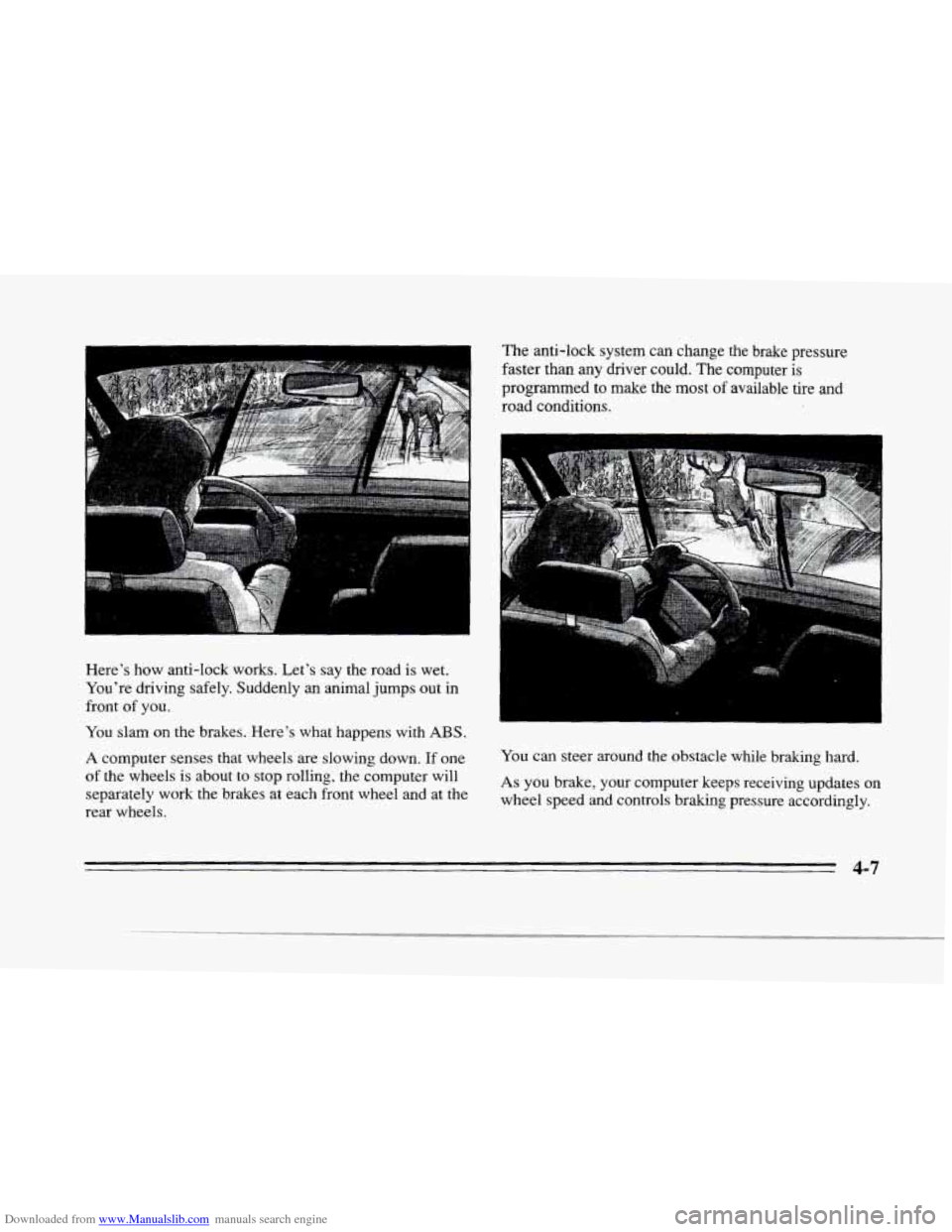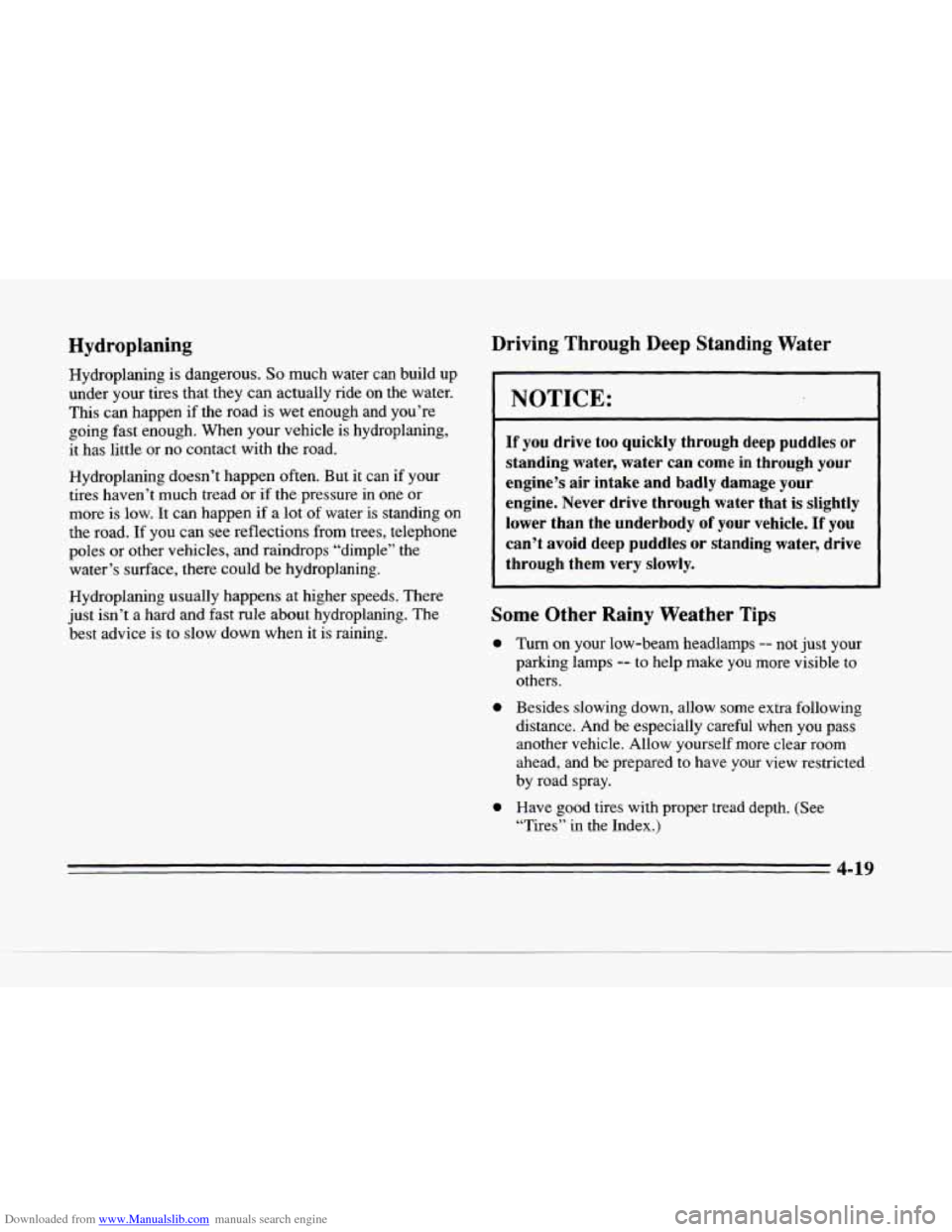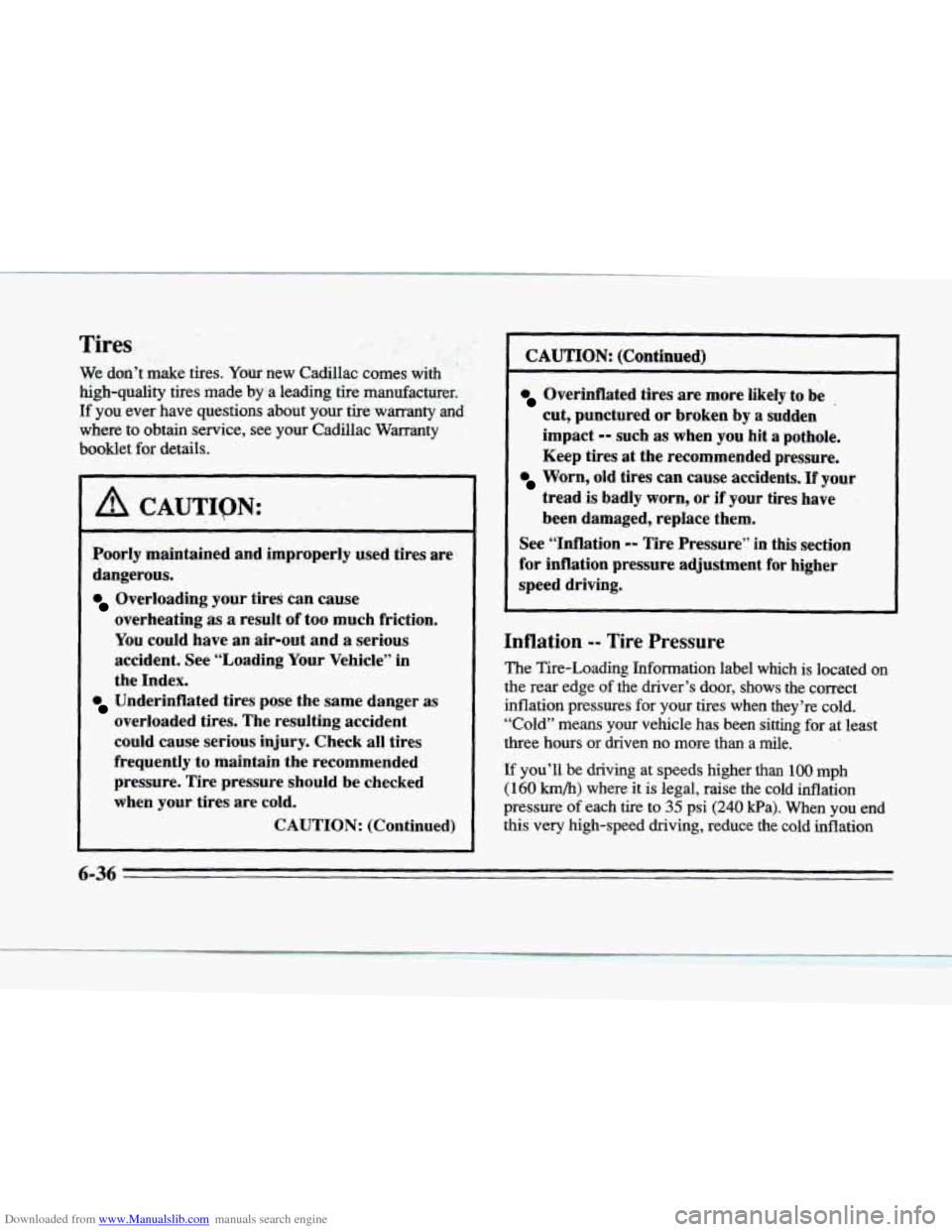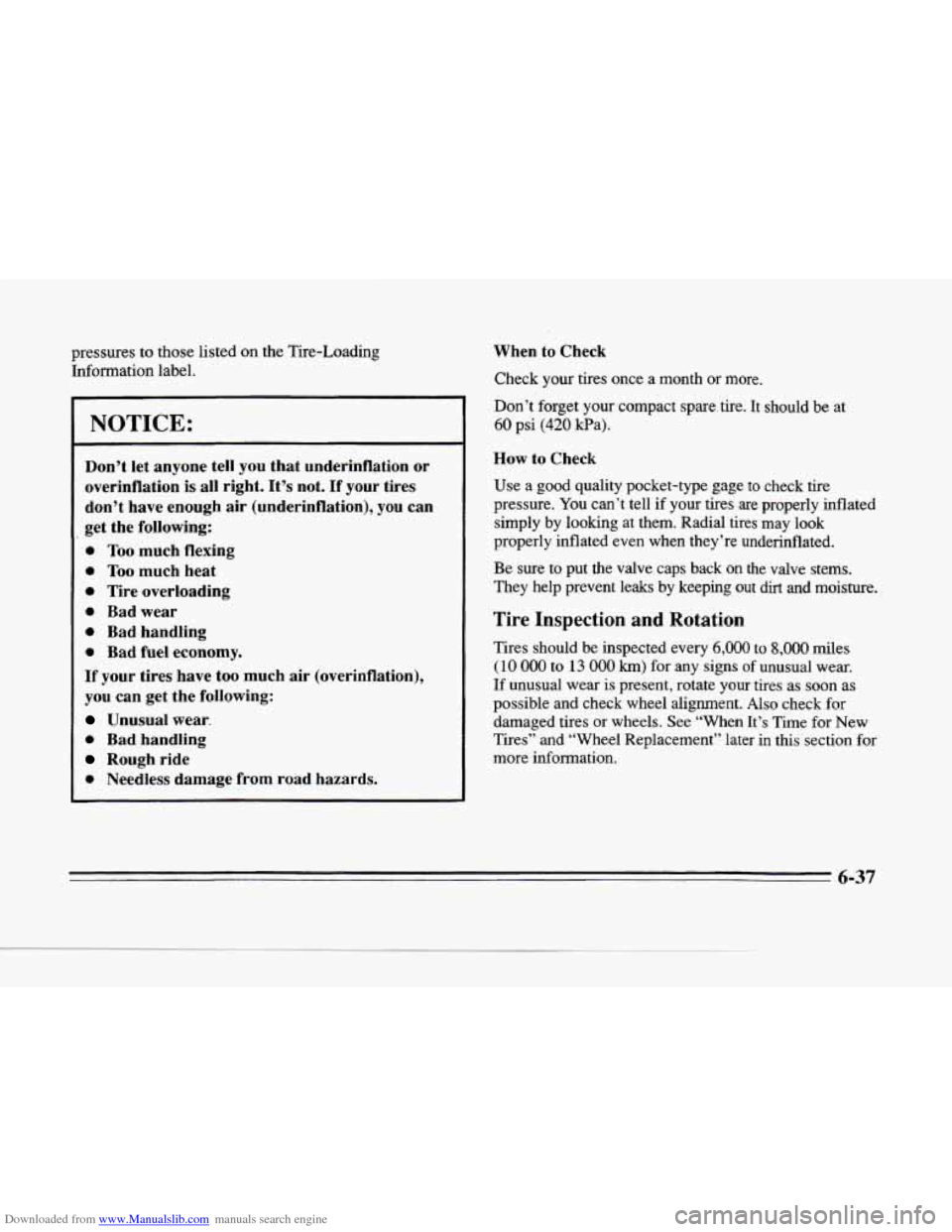1996 CADILLAC SEVILLE tire pressure
[x] Cancel search: tire pressurePage 190 of 354

Downloaded from www.Manualslib.com manuals search engine P
f
r
P
r
Here's how anti-lock works. Let's say the road is wet.
You're driving safely. Suddenly an animal jumps out in
front
of you.
You slam on the brakes. Here's what happens with
ABS.
A computer senses that wheels are slowing down. If one
of the wheels is about to stop rolling, the computer will
separately work
the brakes at each front wheel and at the
rear wheels. The
anti-lock system can change the brake pressure
faster than any driver could. The computer is
programmed to make the most
of available tire and
road conditions.
." .,., ;,. ., ,
You can steer around the obstacle while braking hard.
As you brake, your computer keeps receiving updates on
wheel speed and controls braking pressure accordingly.
4-7
Page 202 of 354

Downloaded from www.Manualslib.com manuals search engine L
Hydroplaning
Hydroplaning is dangerous. So much water can build up
under your tires that they
can actually ride on the water.
This can happen if the
road is wet enough and you’re
going fast enough. When your vehicle is hydroplaning,
it has little or no contact with the road.
Hydroplaning doesn’t happen often. But
it can if your
tires haven’t much tread
or if the pressure in one or
more is low.
It can happen if a lot of water is standing on
the road. If you can see reflections from trees, telephone
poles or other vehicles, and raindrops “dimple” the
water’s surface, there could be hydroplaning.
Hydroplaning usually happens at higher speeds. There
just isn’t a hard and fast rule about hydroplaning.
The
best advice is to slow down when it is raining.
Driving Through Deep Standing Water
~ ~~~~ ~
If you drive too quickly through deep puddles or
standing water, water can come in through your
engine’s air intake and badly damage your
engine. Never drive through
water that is slightly
lower than the underbody
of your vehicle. If you
can’t avoid deep puddles or standing water, drive
through them very slowly.
Some Other Rainy Weather Tips
0
0
0
Turn on your low-beam headlamps -- not just your
parking lamps
-- to help make you more visible to
others.
Besides slowing down, allow
some extra following
distance. And be especially careful when you pass
another vehicle. Allow yourself more clear room
ahead, and
be prepared to have your view restricted
by road spray.
Have good tires with proper tread depth.
(See
“Tires” in the Index.)
Page 205 of 354

Downloaded from www.Manualslib.com manuals search engine The exit speed is usually posted.
Reduce your speed according to your speedometer, not to your sense
of motion. After driving for any distance
at higher speeds, you may tend to think
you are going
slower than you actually are.
Before Leaving on a Long Trip
Make sure you’re ready. Try to be well rested. If you
must start when you’re not fresh
-- such as after a day’s
work
-- don’t plan to make too many miles that first part
of the journey. Wear comfortable clothing and shoes you
can easily drive in.
Is your vehicle ready for a long trip? If you keep it
serviced and maintained, it’s ready to go. If it needs
service, have
it done before starting out. Of course,
you’ll find experienced and able service experts
in
Cadillac dealerships all across North America. They’ll
bc. ready and willing to help if you need it.
Here are some things you can check before a trip:
0
0
0
0
Wilzdshield Washer Fluid: Is the reservoir full? Are
all windows clean inside and outside?
Wiper Blades: Are they in good shape?
Fuel, Engine Oil, Other Fluids: Have you checked
all levels?
Lamps: Are they all working? Are the lenses clean?
Tires: They are vitally important to a safe,
trouble-free trip.
Is the tread good enough for
long-distance driving? Are
the tires all inflated to the
recommended pressure?
Weather Forecasts: What’s the weather outlook
along
your route? Should you delay your trip a short
time to avoid a major
storm system?
Maps: Do you have up-to-date maps?
4-22
Page 212 of 354

Downloaded from www.Manualslib.com manuals search engine c
P
. ‘.
L
-.
Run your engine only as long as you must. This saves
fuel. When you
run the engine, make it go a little faster
than just idle. That
is, push the accelerator slightly. This
uses less fuel for the heat that you get and it keeps the
battery charged.
You wili need a well-charged battery to
restart the vehicle, and possibly for signaling later on
with your headlamps. Let the heater
run for awhile.
Then, shut the engine off and close the window almost
all the way to preserve the heat. Start the engine again
and repeat this only when you feel really uncomfortable
from the cold. But do it as little
as possible. Preserve the
fuel as long as you can.
To help keep warm, you can get
out of the vehicle and do some fairly vigorous exercises
every half hour
or so until help comes.
Loading Your Vehicle
(m OCCUPANTS VEHICLE CAP. WT.
TIRE-LOADING INFORMATION
FRT. CTR. RR. TOTAL LBS. KG
MAX. LOADING & GVWR SAME AS VEHICLE
CAPACITY WEIGHT XXX COLD TIRE
TIRE SIZE SPEED PRESSURE
RTG PSliKPa
FRT.
RR.
SPA.
IF TIRES ARE HOT, ADD 4PSI. 28KPa
SEE OWNER’S MANUAL FOR ADDITIONAL
INFORMATION
Two labels on your vehicle show how much weight it
may properly carry. The Tire-Loading Information label
found on the driver’s
door tells you the proper size,
speed rating and recommended inflation pressures for
the tires on your vehicle. It also gives you important
information about the number
of people that can be in
your vehicle and the total weight that you can carry.
This weight
is called the Vehicle Capacity Weight and
includes the weight
of all occupants, cargo and all
options not installed in the factory.
d
Page 217 of 354

Downloaded from www.Manualslib.com manuals search engine If you’re using a “dead-weight” hitch, the trailer
tongue
(A) should weigh 10% of the total loaded trailer
weight
(B). If you have a “weight-distributing” hitch,
the trailer tongue
(A) should weigh 12% of the total
loaded trailer weight
(B).
After you’ve loaded your trailer, weigh the trailer and
then the tongue, separately,
to see if the weights are
proper.
If they aren’t, you may be able to get them right
simply by moving some items around in the trailer.
Total Weight on Your Vehicle’s Tires
Be sure your vehicle’s tires are inflated to the
recommended pressure for cold tires. You’ll find these
numbers
on the Certification label at the rear edge of the
driver’s
door or see “Loading Your Vehicle” in the
Index.
Then be sure you don’t go over the GVW limit
for your vehicle, including the weight of the trailer
tongue.
Hitches
It’s important to have the correct hitch equipment.
Crosswinds, large trucks going by and rough roads
are
a few reasons why you’ll need the right hitch. Here are
some
rules to follow:
0 Will you have to make any holes in the body of your
vehicle when you install
a trailer hitch? If you do,
then be sure to seal the holes later
when you remove
the hitch.
If you don’t seal them, deadly carbon
monoxide (CO) from your exhaust can get into your
vehicle (see “Carbon Monoxide”
in the Index).
Dirt and water can, too.
The bumpers
on your vehicle are not intended for
hitches.
Do not attach rental hitches or other
bumper-type hitches
to them. Use only a
frame-mounted hitch that does not attach to the
bumper.
4-34
Page 256 of 354

Downloaded from www.Manualslib.com manuals search engine P
c
The compact spare is for temporary use only. Replace
the compact spare tire with
a full-size tire as soon as you
can. See the storage instructions label to replace your
compact spare into your trunk properly.
Compact Spare Tire
Although the compact spare tire was fully inflated when
your vehicle was new, it can lose
air after a time. Check
the inflation pressure regularly.
It should be 60 psi
(420 kPa).
After installing the compact spare
on your vehicle, you
should stop as soon as possible
and make sure your
spare tire is correctly inflated. The compact spare. is
made to perform well at posted speed limits for
distances up to
3,000 miles (5 000 km), so you can
finish your trip and have your full-size tire repaired
or
replaced where you want. Of course, it’s best to replace
your spare with a full-size tire as
soon as you can. Your
spare will last longer and be in
good shape in case you
need
it again.
5-35
Page 295 of 354

Downloaded from www.Manualslib.com manuals search engine Tires
c4; f **I- *.: C
We don’t make tires. Your new Cadillac comes with
high-quality tires made by
a leading tire manufacturer.
If you ever have questions about your tire warranty and
where
to obtain service, see your Cadillac Warranty
booklet for details.
A CAUTION:
Poorly maintained and improperly used tires are
dangerous.
Overloading your tires can cause
overheating
as a result of too much friction.
You could have an air-out and a serious
accident. See “Loading Your Vehicle” in
the Index.
Underinflated tires pose the same danger as
overloaded tires. The resulting accident
could cause serious injury. Check all tires
frequently
to maintain the recommended
pressure. Tire pressure should
be checked
when your tires are cold.
CAUTION: (Continued)
CAUTION: (Continued)
Overinflated tires are more likely to be
cut, punctured or broken
by a sudden
impact
-- such as when you hit a pothole.
Keep tires at the recommended pressure.
Worn, old tires can cause accidents. If your
tread is badly worn, or if your tires have
been damaged, replace them.
See “Inflation
-- Tire Pressure” in this section
for inflation pressure adjustment
for higher
speed driving.
Inflation -- Tire Pressure
The Tire-Loading Information label which is located on
the
rear edge of the driver’s door, shows the correct
inflation pressures for your tires when they’re cold.
“Cold” means your vehicle has been sitting for at least
three hours or driven no more than a mile.
If you’ll be driving at speeds higher than 100 mph
(160’km/h) where it is legal, raise the cold inflation
pressure of each tire to
35 psi (240 Wa). When you end
this very high-speed driving, reduce the cold inflation
6-36
Page 296 of 354

Downloaded from www.Manualslib.com manuals search engine c
rc
pressures to those listed on the Tire-Loading
Information label.
NOTICE:
Don’t let anyone tell you that underinflation or
overinflation
is all right. It’s not. If your tires
don’t have enough
air (underinflation), you can
get the following:
0 Too much flexing
0 Too much heat
0 Tire overloading
0 Bad wear
0 Bad handling
0 Bad fuel economy.
If your tires have too much air (overinflation),
you can get the following:
Unusual wear.
0 Bad handling
Rough ride
0 Needless damage from road hazards. When to
Check
Check
your tires once a month or more.
Don’t forget your compact spare.
tire. It should be at
60 psi (420 kPa).
How
to Check
Use a mod quality pocket-type gage to check tire
pressure. You can’t tell if your tires are properly inflated
simply by looking at them. Radial tires may look
properly inflated even when they’re underinflated.
Be sure to put the valve caps back
on the valve stems.
They help prevent leaks by keeping out dirt
and moisture.
Tire Inspection and Rotation
Tires should be inspected every 6,000 to 8,000 miles
( 10 000 to 13 000 km) for any signs of unusual wear.
If unusual wear is present, rotate your tires as soon as
possible and check wheel alignment. Also check for
damaged tires or wheels. See
“When It’s Time for New
Tires” and “Wheel Replacement” later
in this section for
more information.
6-37